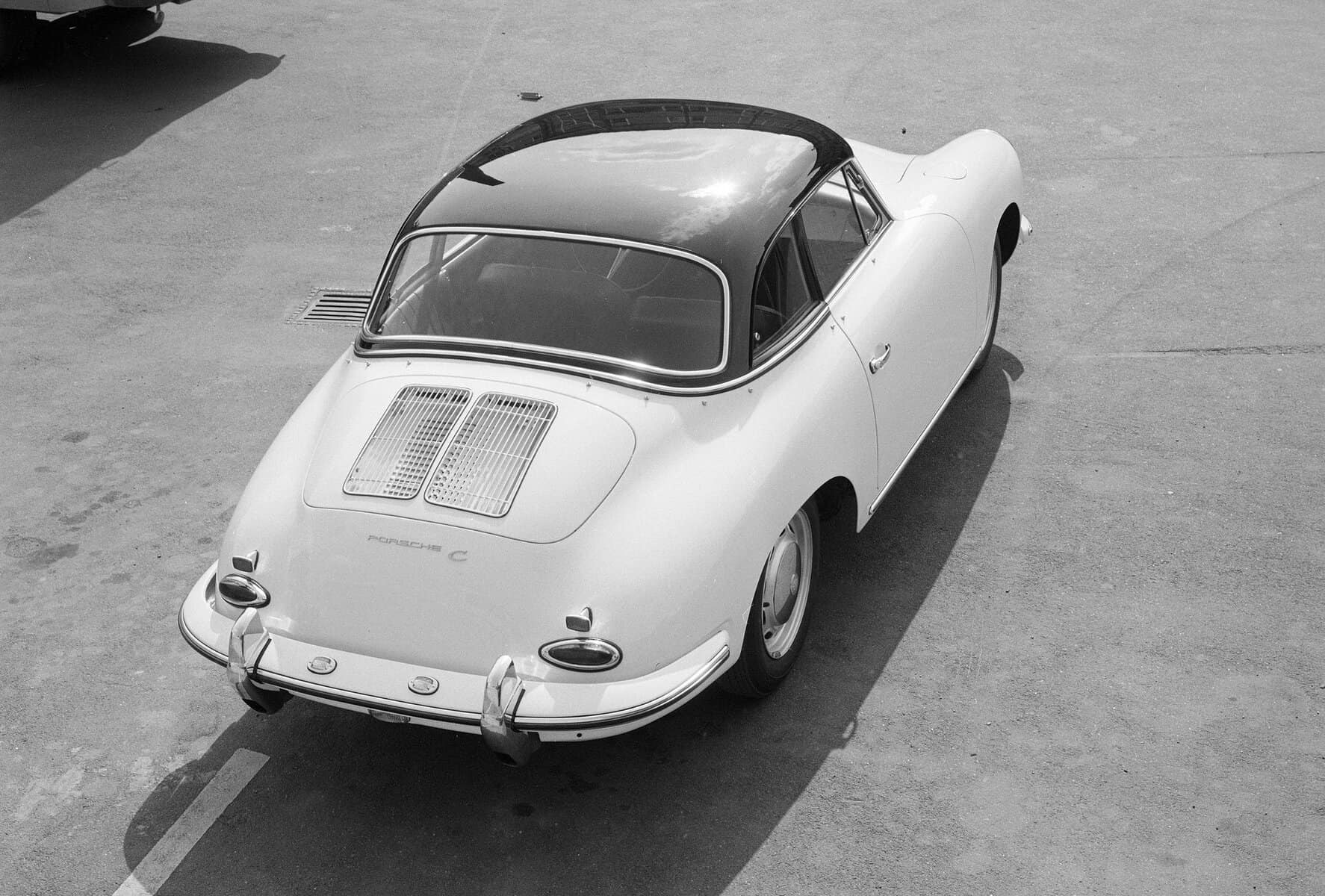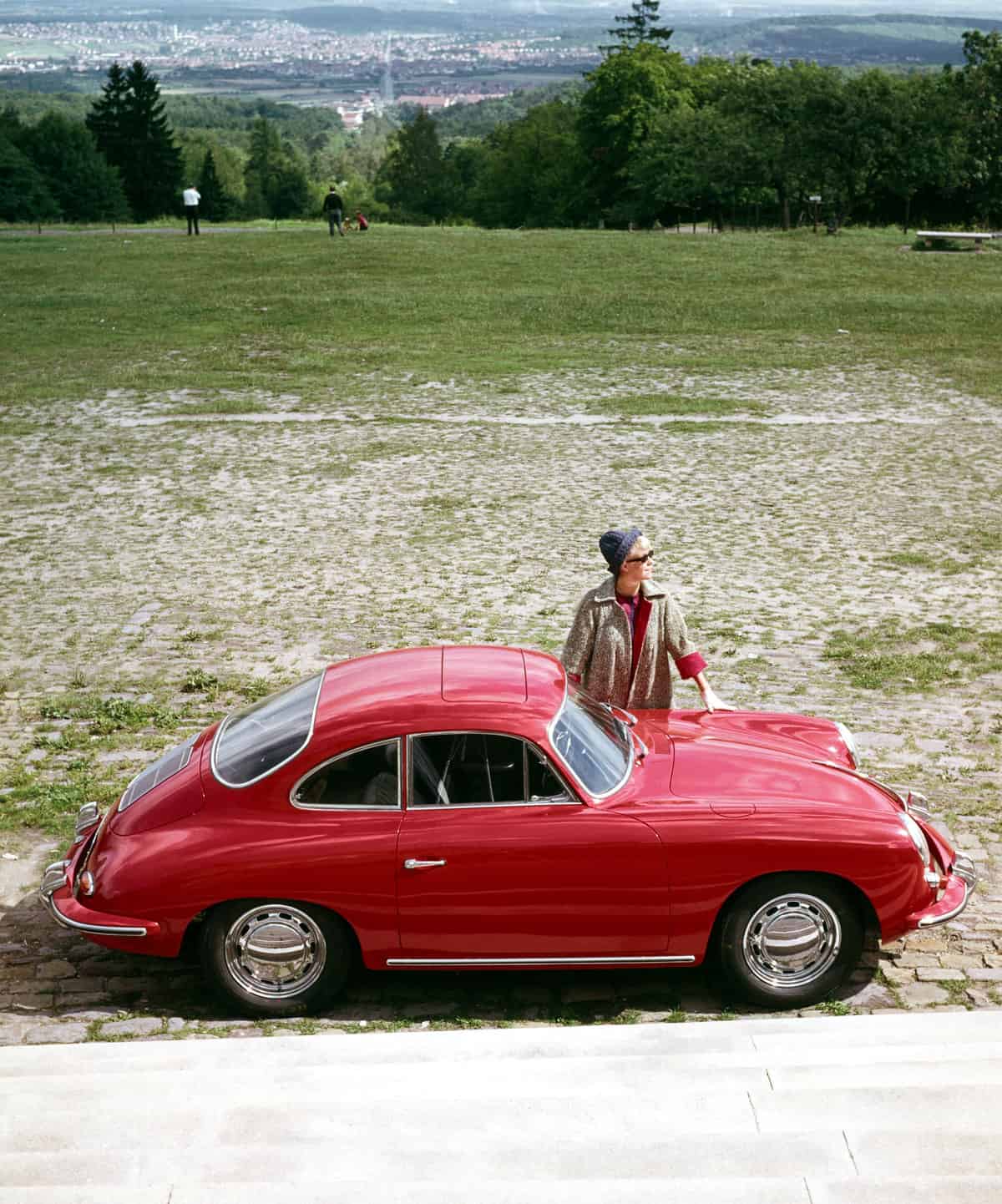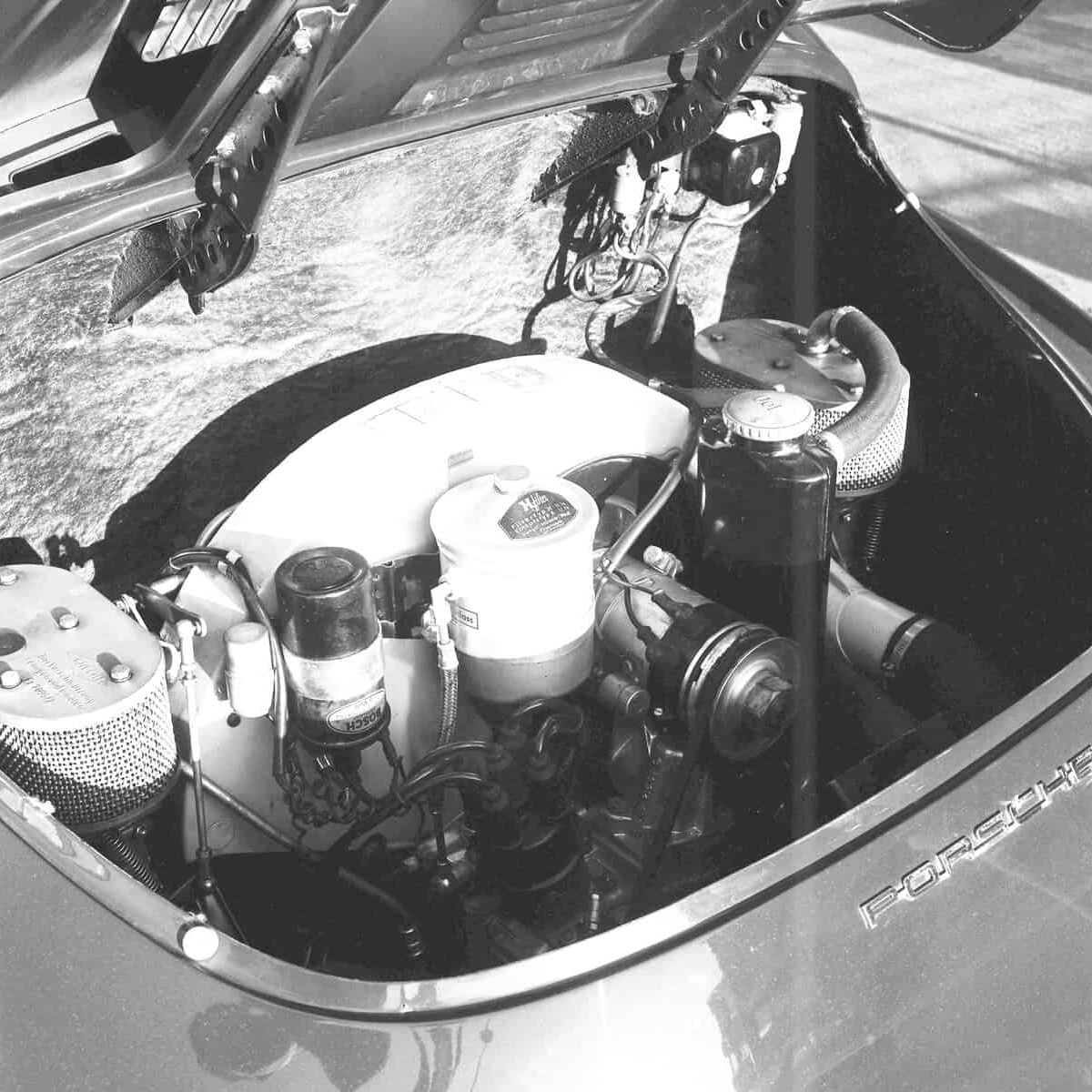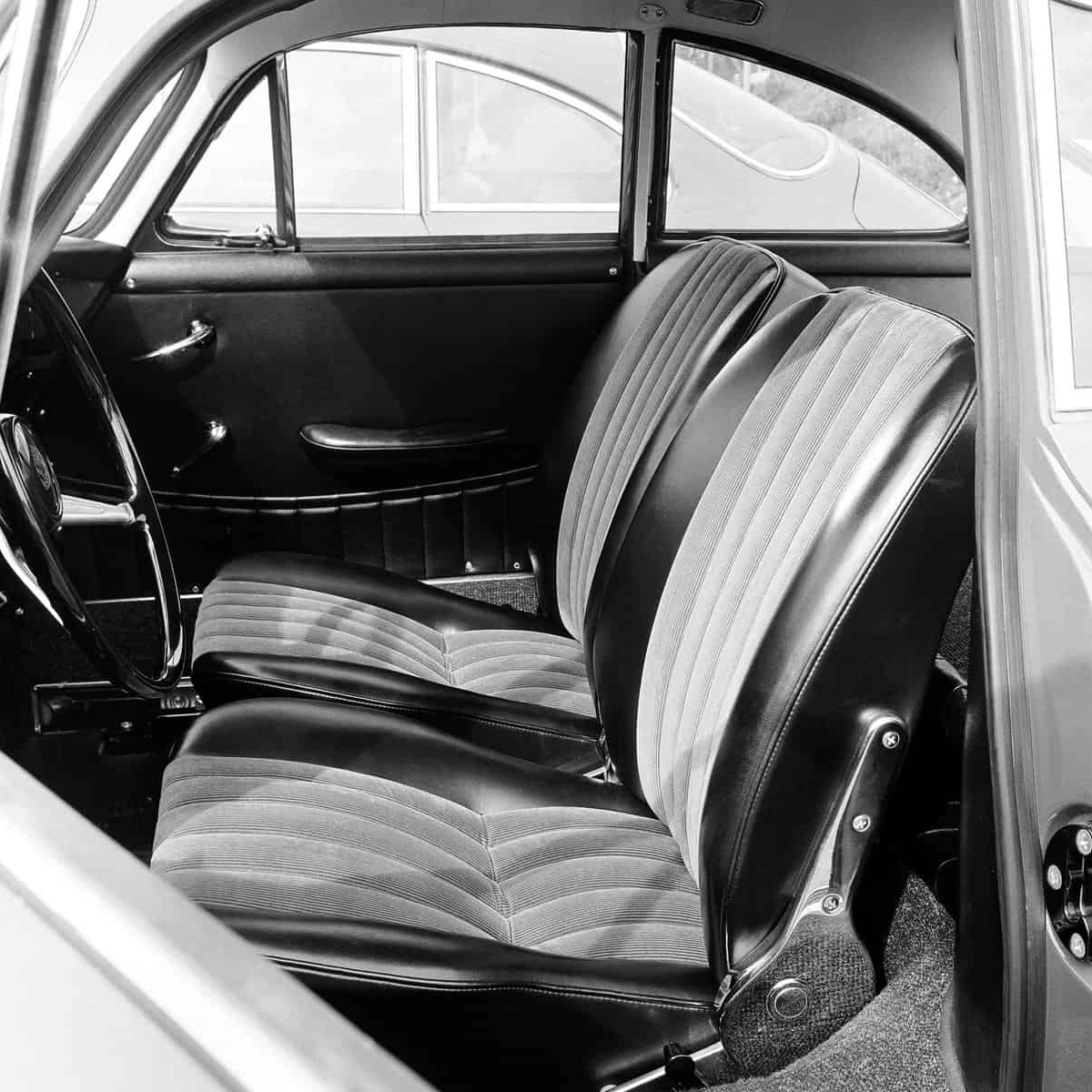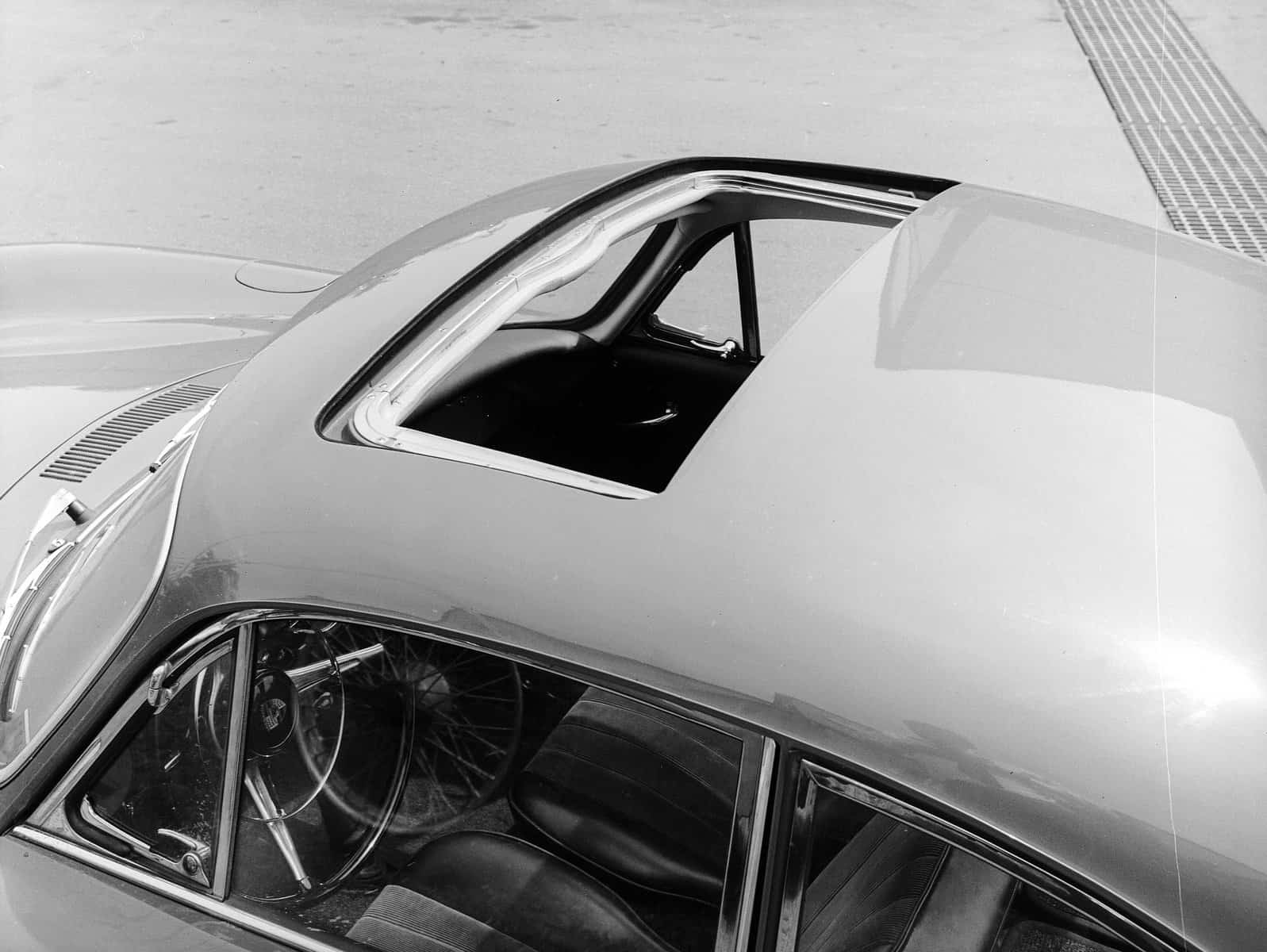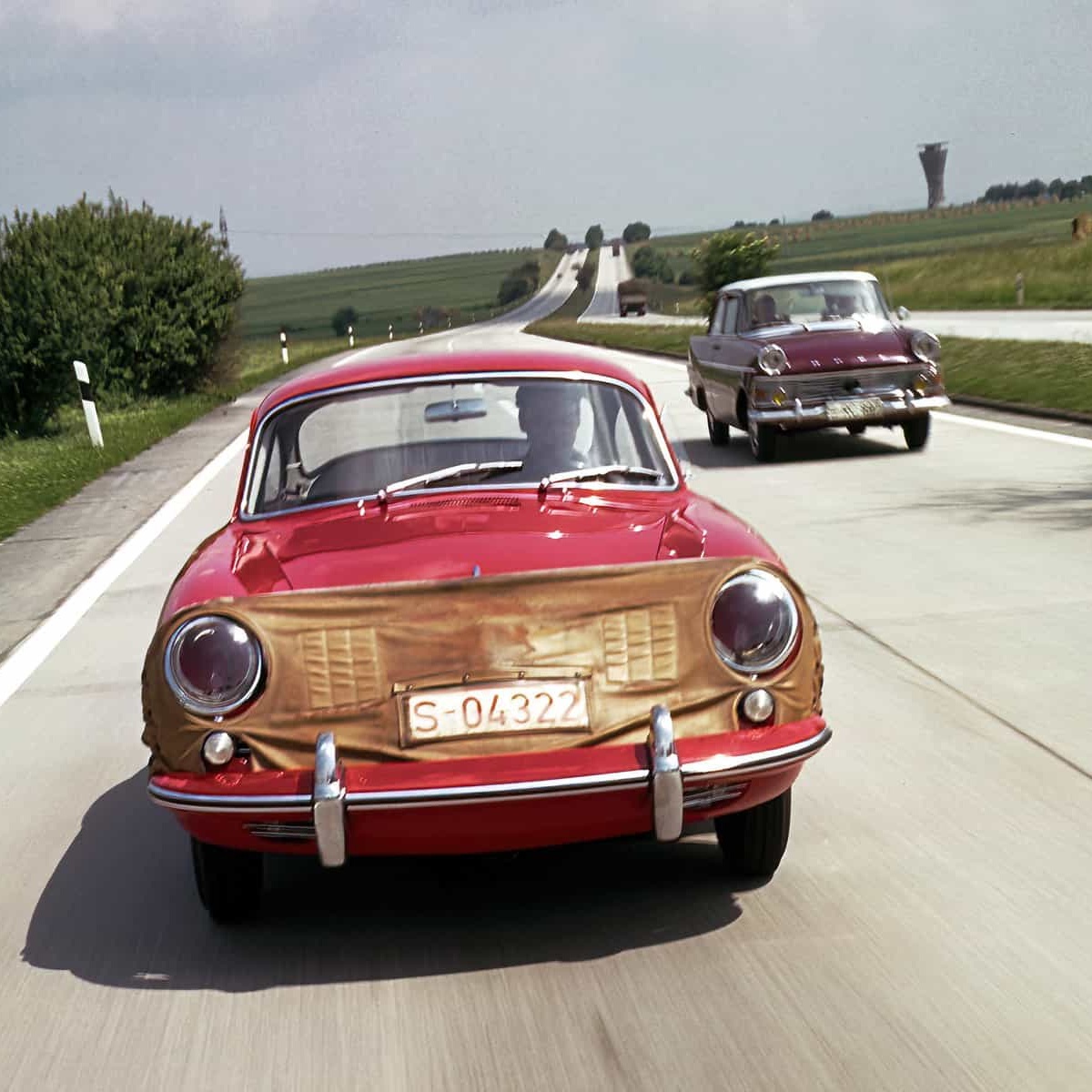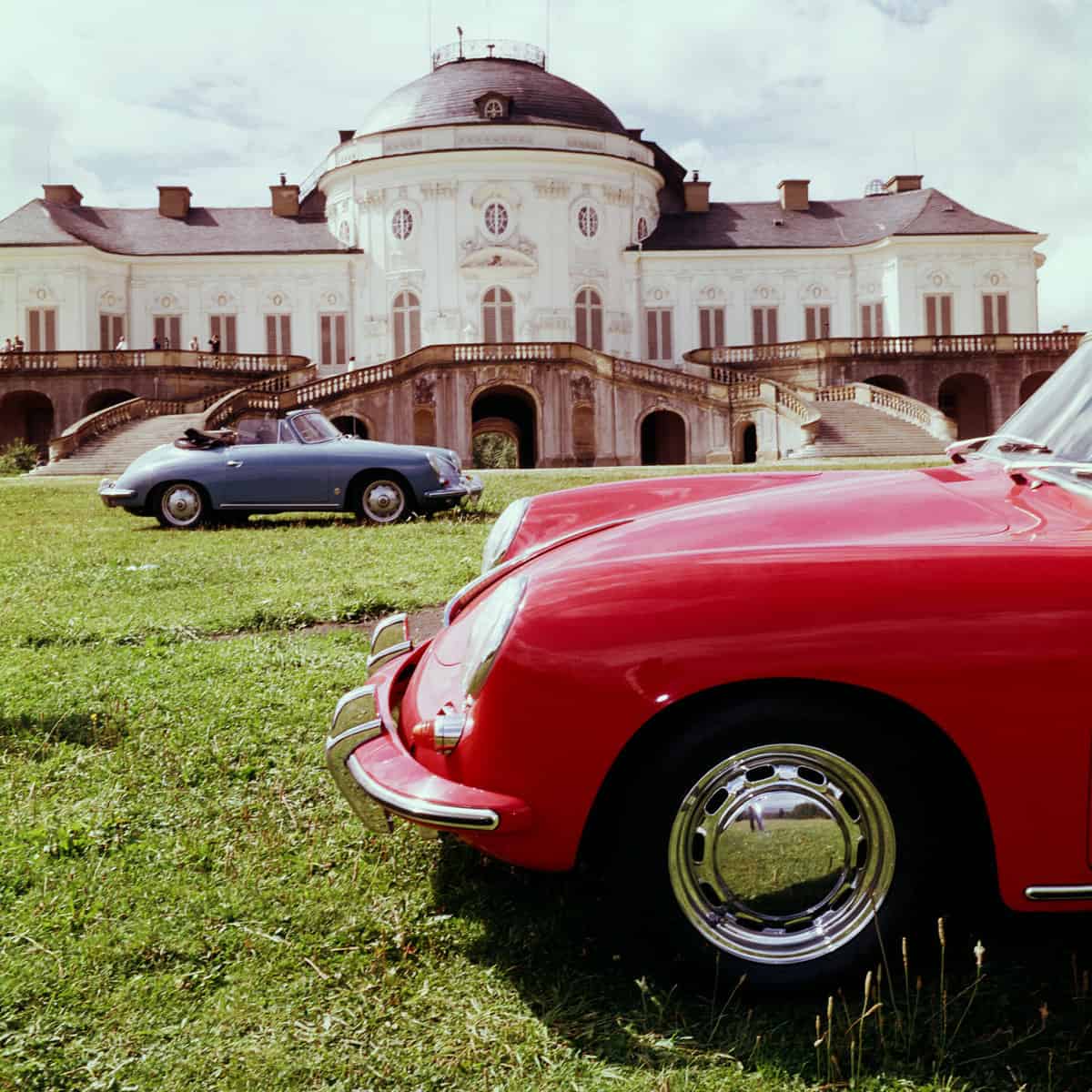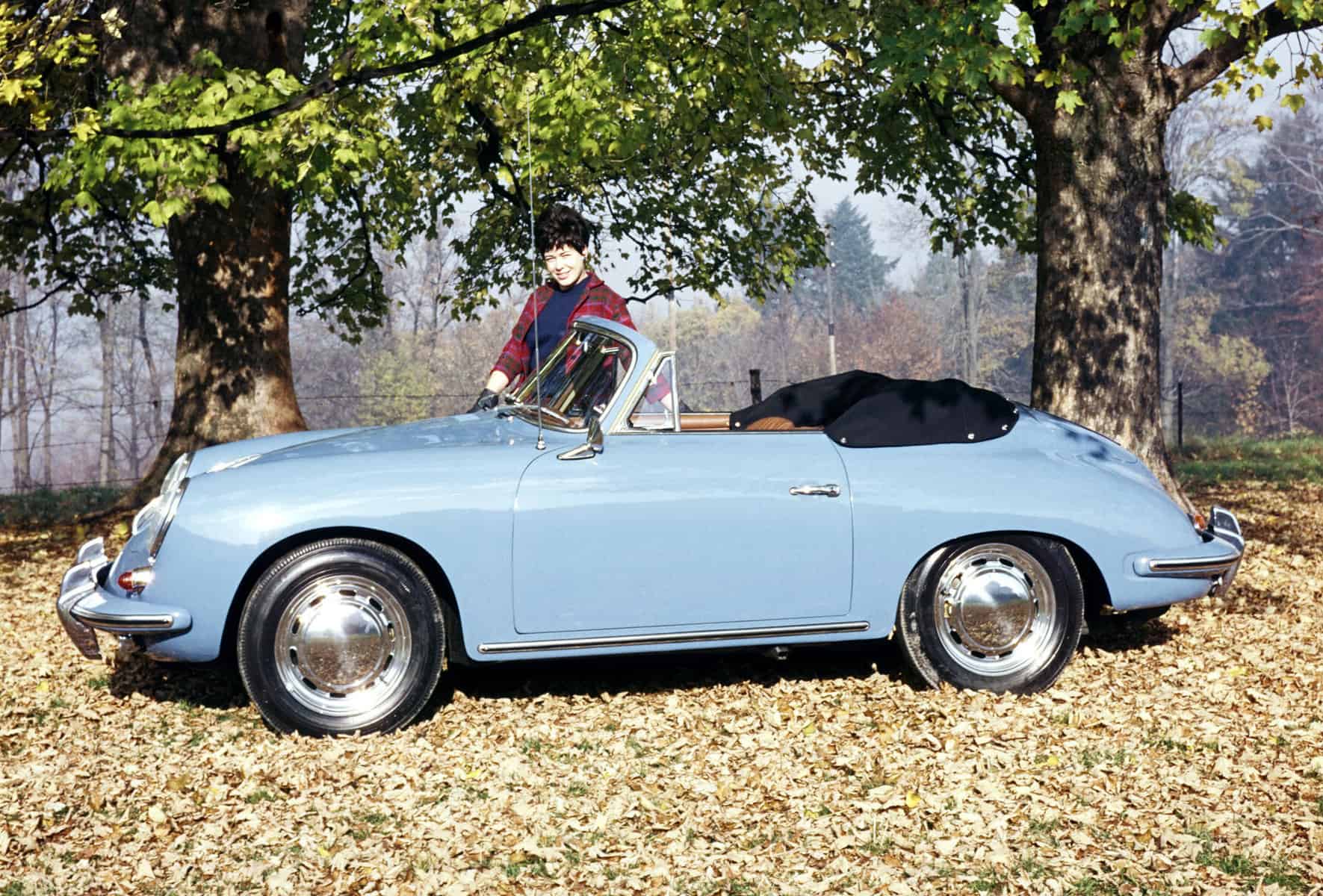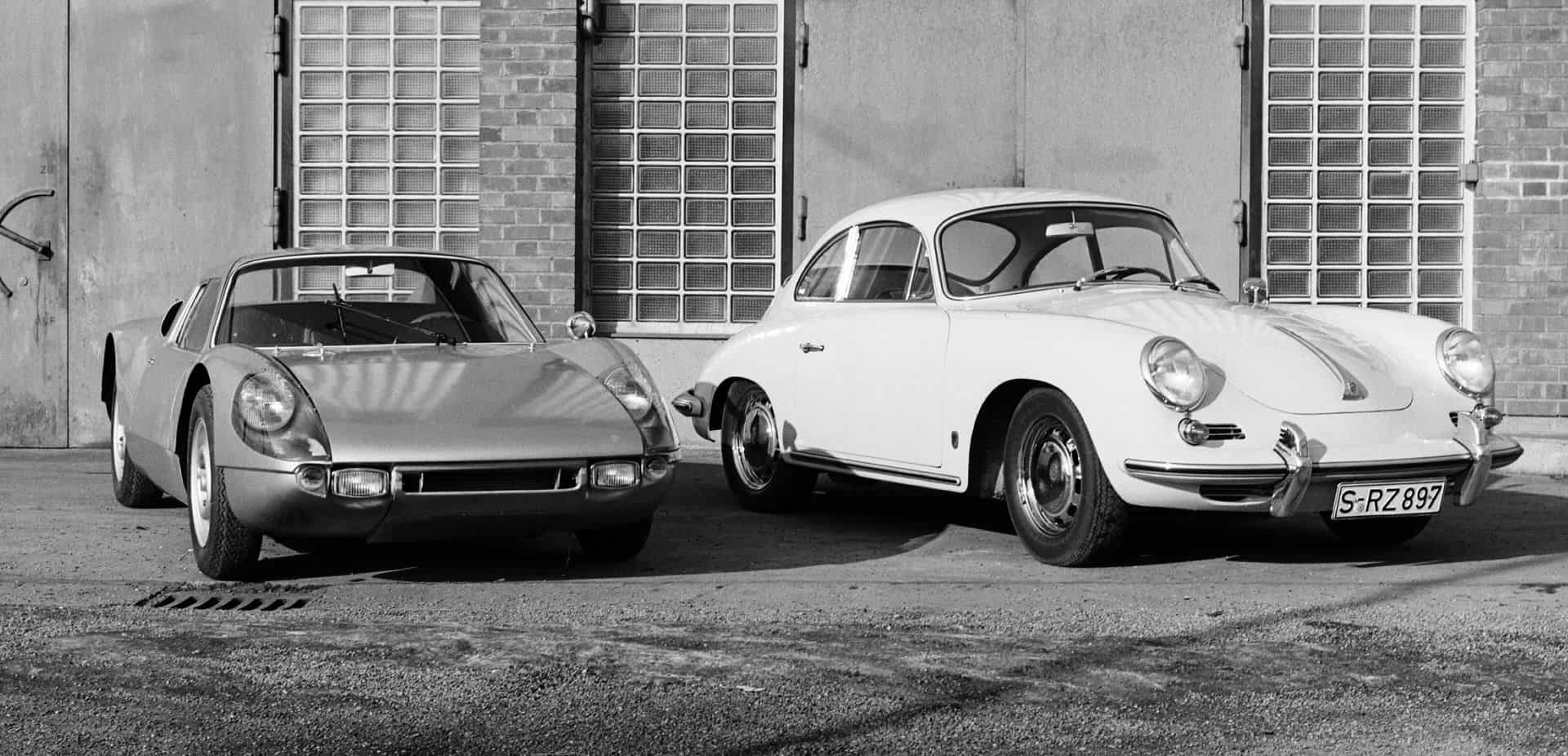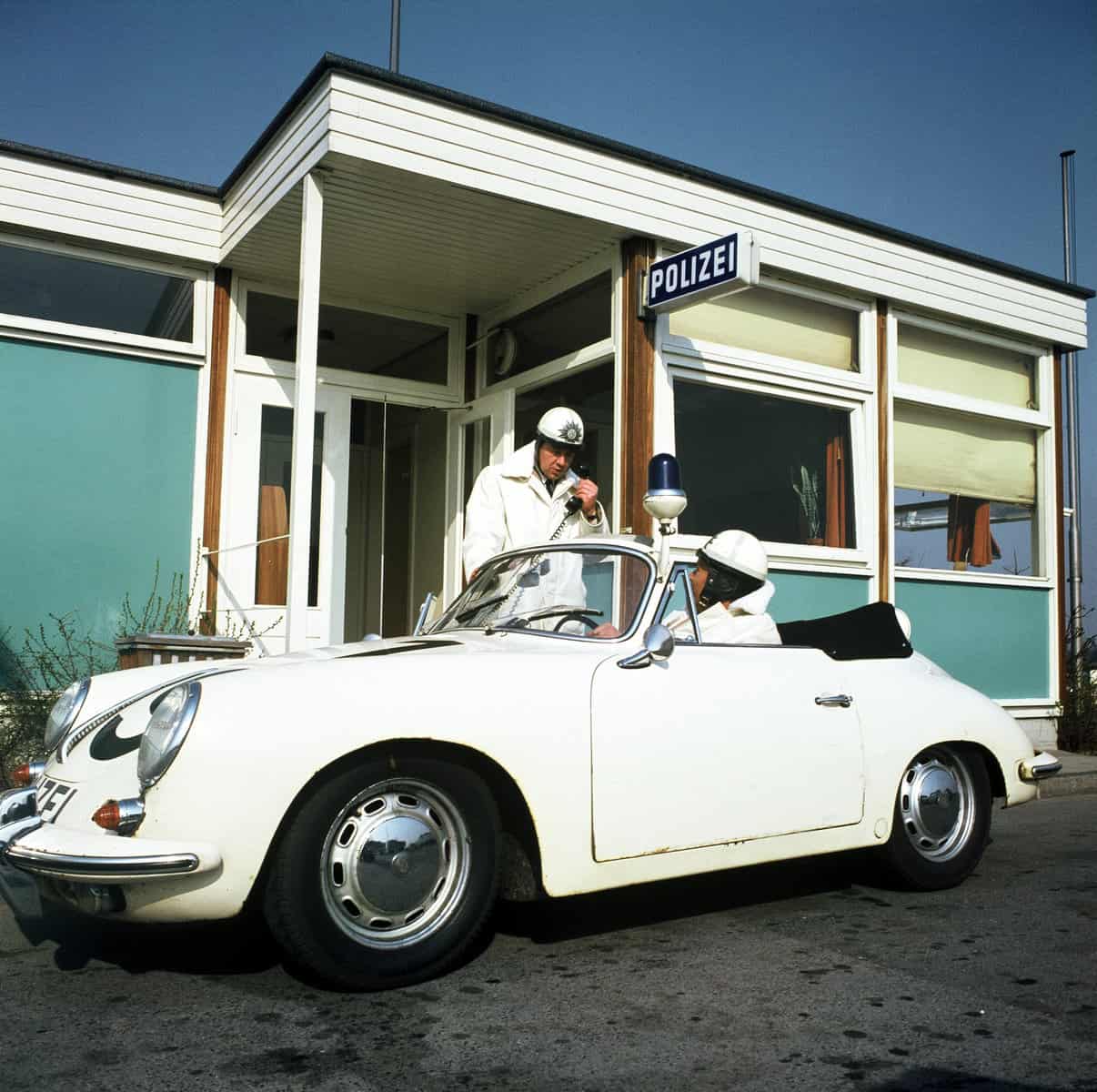Charlie Porsche – the Final 356
When the curtain came down on a star car
WORDS & IMAGES BY: KARL LUDVIGSEN
When the end of its 356 was in sight, Zuffenhausen made sure that its star car bowed out with the best of engines, suspensions, and equipment. The official curtain came down on April 28, 1965.
In the autumn of 1965 the car on which the Porsche automobile reputation was built became a museum piece. In fact 1963 was the last year in which normal sports-car production from Zuffenhausen would consist entirely of models derived from the Type 356. New designs, the 911 and 912, took an ever-increasing share of total output, which grew to 10,808 cars in 1964 and 11,243 in 1965. At the close of the latter year the classic 356 was no longer part of the Porsche range. But it departed with a flourish in its final form, the much-improved Type 356 C.
The new designation for the 1964 model was the result chiefly of changes in its brakes and engine. Its body, dating from the T-6 program of 1961–62, was carried over to the C-model with only minor alterations.
On July 1, 1963, the first 356 C bodies were delivered to the Porsche plant from the adjacent Reutter factory—which Porsche had taken over that year—in preparation for the debut of the 356 C in the press in August and at the Frankfurt Show, which opened on September 12. With Reutter deeply committed to the launch of the 911, however, coachbuilder Karmann continued the coupe production it had begun, with the 356 B to be an important source of closed bodies for the 356 C to the end of its run.
After trying a 356 C at the motor show Motor Sport’s correspondent noted, “it was soon apparent that Porsche engineers read magazine road-test reports for the heater knob has been replaced by a lever and the awkwardly placed light switch has been moved so that the driver does not have to reach through the steering wheel to operate it.” In such ways Porsche continued to buff its well-earned reputation for careful attention to detail.
Other items repositioned to the right of the steering column on an amended dash panel were the wiper control and cigar lighter. A rocker-type switch was provided for the interior lamps, coupe passengers having the benefit of a reading lamp. Condensation on the rear window was cleared by two warm-air ducts. When the rear seat backs were folded down for luggage, new ridges at the front kept it from sliding forward.
Other new touches were deeper seats that slightly increased headroom and standard-equipment armrests that also served as door-closing grips. The former chromed passenger-assist grip was replaced by a larger black plastic item. The glove compartment lid was now retained magnetically instead of by a latch. Carried over from the 356 B was the Cabrio’s rear window, which could be unzipped from inside or outside and folded down to give fresh-air flow. A hardtop was an option for Cabrio buyers.
Subtle suspension changes tended both to improve the ride and to reduce oversteer. To enhance understeer the diameter of the front anti-roll bar was increased by 1 mm while to improve the ride the torsion bars suspending the rear wheels were reduced in diameter from 23 to 22 mm. The transverse compensating spring at the rear was standard only on the models with the most potent engines, the 1600 SC and the Carrera 2, remaining optional on other models. Dampers were Boge for the C and gas-pressurized Konis for the SC.
The sole external recognition point of the 356 C, apart from its rear-deck badges, was its new wheel and hubcap design. A direct result of the adoption of four-wheel disc brakes, this change was historic. It meant abandonment of the distinctive combined brake and wheel design that had hitherto been a Porsche hallmark
The reason for this was that the brake chosen was not Porsche’s own Type 695 conception. The unusual qualities that made it so light and effective also helped disqualify the Porsche disc brake for mass production. Its mechanical and hydraulic parts were not entirely compatible with those disc systems that were going into quantity manufacture for more and more marques.
Porsche’s own sales volume was not, of course, large enough for the company to swing the rest of the industry around to its point of view. Furthermore a major advocate of the Porsche brake and its joint inventor, technical chief Nikolaus “Klaus” von Rücker, was no longer around to press for its use. He left Porsche in October 1961.
A little more than a year later Porsche ended its involvement in Formula 1 Grand Prix racing, for which it continued to use its own brake design. At the same time it turned its disc-brake patents over to the Alfred Teves firm, which became the supplier of brakes for the 356 C.
Thus did Teves, better known by its “Ate” trademark, finally win the competition for the Porsche business that it had begun in 1958 with the Dunlop discs it represented and made under license. It did so not by stubbornly insisting on its own design but rather by adapting its brake to meet Porsche’s requirements.
Each disc-gripping caliper had a single piston on each side—the Porsche brake had two on each side—with a special adjustment mechanism developed by Porsche. The caliper provided automatic lining adjustment, maintained a small running clearance, and restored the piston to its proper position after momentary disturbances such as the flexing of the disc’s alignment during hard cornering.
Porsche patents were incorporated in the Ate brakes in another important way—the use of a little drum-type brake for parking. This was hidden inside the rear-brake discs, each of which was given a deep, hat-like shape to form the seven-inch drums against which rubbed the mechanically actuated shoes.
The rear brake discs were given a slightly larger diameter than those in front, 11.2 instead of 10.8 inches, to allow enough room for the parking brakes. Disc thickness was 10.5 mm in front and 10.0 mm in the rear.
Although the method was not the cheapest, this Porsche hand-brake notion really did the business. Said Motor in its test of a 1964 1600 SC, “Worked through a mechanical linkage from the twist-and-pull handbrake beneath the facia, these small drums are surprisingly powerful and will easily lock the rear wheels or hold the car on a 1 in 3 slope.”
The British weekly gave the new disc brakes qualified approval, “For high-speed stopping, the discs are a success. Pedal forces are rather heavy but…even the hardest use failed to raise them by more than a few pounds and recovery was quick. There was never any deviation from a straight line and the brakes remained quiet throughout.” An amenity of the new system was a translucent brake-fluid reservoir readily visible in the front trunk compartment.
New brakes required new wheels. For the first time on a 356-series Porsche, conventional full-disc wheels were used. They were attached by five studs covered by smaller, flatter hubcaps than those previously used. Perforated with a ring of oval vents similar to those used on its predecessor, the new wheel kept a 4.5-inch rim width.
With the launching of the 356 C the pushrod-engine range was brought back to the relative simplicity it had enjoyed in the late 1950s: now there were just two engine choices. This was achieved by dropping the least potent engine, the 60-horsepower “Normal,” and by giving important refinements to the two that remained. The 1600 S or Super 75 became the 1600 C (Type 616/15), while the Super 90 was transformed into the 1600 SC (Type 616/16). These two engines powered the 356 C through its final two years of life.
Development of the new engine range was supervised by Hans Mezger, who had been working on Porsche’s Grand Prix car design and testing program throughout much of 1962. Born in Ottmarsheim, near Stuttgart, Mezger joined Porsche in 1956 at the age of twenty-six. His first assignment was in the computations department under Egon Forstner, where he saw a chance of being involved with sports-car development. “I liked the look and design of the Porsche from the moment I saw it,” Mezger recalled.
One aim was to rationalize the engine design for more efficient manufacturing. Another objective was to get from the former Super 90 the 90 or more horsepower that it never possessed in production. The result was the best-ever engine family for the 356.
“Whenever more power had been needed before,” Hans Mezger explained, “the inlet valves had always been made larger, but not the exhaust valves. In consequence they had become much too small.” He took the radical step of reducing the inlet-valve diameter from 40 to 38 mm so that the exhaust valve could be made larger, 34 instead of 31 mm. At the same time Mezger reshaped the inlet and exhaust ports, improving flow by making their cross-sectional area more nearly constant.
Sharing the same valve sizes and basic head design, some cylinder heads were specified by Mezger to be anodized black for better heat dissipation. Breathing of the 1600 SC was kept at a high level by its continued use of the Super 90 camshaft. Produced as usual by Munich’s Schleicher Fahrzeugteile, a new camshaft was developed for the 1600 C that offered timing similar to that of the old 1600 with moderately reduced lift. Triple-grooved valve stems matched new split keepers and spring retainers. Sodium-cooled exhaust valves were fitted to the 1600 SC engines.
New piston-crown and combustion-chamber contours gave compression ratios of 8.5:1 and 9.5:1 for the two versions of the flat four. Each had its own inlet manifolding and carburetion: Zenith 32 NDIX units for the 1600 C and Solex 40 PII-4 instruments for the 1600 SC. Both were fed by external piping to meet the new American requirements for positive crankcase ventilation, fitted to reduce engine emissions. They had much-enlarged breather chambers around the oil-filler cap and hoses to take unburned hydrocarbons from the crankcase to the carburetor inlets.
Further refined in detail, crankcases for both engines were identical. They retained the Super 90’s enlarged 55 mm main-bearing size for the journals at the center and nose of the crank and used the smaller original size of 50 mm for the bearing next to the flywheel. The overhung bearing carried by the timing case remained at its 40 mm diameter. Only the shells of the two large main bearings were fitted with hard steel-backed lead-bronze inserts.
Hans Mezger applied some of his growing racing know-how to the design of the crankshaft for the 1600 SC engine that, unlike that of its less potent sister, was fitted with four large integral counterweights for smoother running at high revs. This helped elevate the speed at which its peak power was reached to 5,800 rpm, the highest such figure yet for a normally catalogued pushrod Porsche. This was also the SC’s tachometer redline, though it could be run safely to 6,000 rpm. Indeed, Porsche pushers reported that revs of 6,500 to 7,000 rpm were safely allowable if not overindulged.
Output of the 1600 SC was a satisfying 95 hp net at 5,800 rpm, 107 hp gross. Torque delivery peaked at 4,200 rpm with 91 pound-feet. The 1600 C delivered its maximum power of 75 net hp at 5,200 rpm, with a power curve almost identical with that of the SC from 1,500 to 4,000 rpm, at which point the SC’s cam and carburetion began making their presence known.
Cast-iron cylinders were used in the milder 1600 C engine, while at its introduction the SC had aluminum cylinders with a Ferral bore coating, carried over from the Super 90. During 1964, however, these were supplanted by yet another cylinder construction, made for Porsche under the “Biral” trade name. These consisted of a cast-iron sleeve around which a finned aluminum muff was cast in place in such a way as to form a mechanical bond between the two materials. This allowed better transfer of heat from the iron to the aluminum, thence to the air.
Drivetrain improvements included a 200 mm clutch for both engines. In the transmission the synchronizing rings were more robust to improve durability. Really racy buyers could specify a limited-slip differential.
Testing an SC coupe, the UK’s Motor gave its impressions of the behavior of this new Type 616/16 engine: “The engine idles with a little flutter from the back; when the throttle is opened there is an intake roar from the carburetors which does not increase much with speed. Fan whine does, however, and this is a car which one normally drives with the windows shut keeping out most of the noise. Under hard acceleration there is a certain throb but most of this is noise, not vibration.
“The acceleration is not the sort that jerks your head back,” added Motor. “It is more the progressive kind that goes on a long time very uniformly in every gear without the car feeling much faster or even getting much noisier.” In the case of the car tested by Motor the acceleration was not even very good when compared with Porsche’s own data on a similar car:
Performance: Type 356 C Porsche Coupes
Power unit 1600 C 1600 C 1600 SC 1600 SC
Tester*
0–50 mph (sec.) 8.3 9.9 7.6 9.2
0–60 mph (sec.) 12.2 13.5 10.8 13.2
0–70 mph (sec.) 16.5 18.0 14.5 16.7
0–80 mph (sec.) 22.4 23.1 18.8 21.2
0–90 mph (sec.) 33.6 32.8 24.7 31.4
0–100 mph (sec.) 61.5 53.0 34.8 43.2
Standing ¼ mile (sec.) — 18.9 — 18.7
Maximum speed (mph) 109.0 100.0 115.0 112.5
*PE = Porsche Engineering, R&T = Road & Track M = Motor
The two publications returned excellent fuel-mileage figures for these cars but because they were Porsches their economy was all but taken for granted. Motor quoted mileage of 22 to 24 miles per United States gallon for the SC while Road & Track cited a range of 24 to 28 mpg for the C-engined car.
As tested on the new Weissach skid pad, with the latest belted radial tires the 356 C was capable of generating a cornering acceleration of more than eight-tenths that of gravity, specifically between 0.81 and 0.83 g depending on the diameter of the test circle. This was a very good value for the time; a European sedan with the same tires cornered at no better than 0.73 g.
This was the quantitative measure of the 356 C’s handling, using terms with which Porsche’s engineers were becoming more and more familiar. In its 1600 SC test Motor aptly summed up the qualitative aspects of Porsche handling in these last years of the Type 356:
“Slow corners produce some understeer. As the speed is built up this alters gradually and progressively to a neutral condition, then oversteer, culminating in the back gently breaking away. Few people will drive fast enough on the road to reach this condition. Steering is high-geared and fairly light at moderate speeds. Very strong castor action makes it rather heavy when cornering hard on sharp bends.”
In 1964 Road & Track’s European correspondent, Henry Manney, borrowed Huschke von Hanstein’s hardtop to see what 1600 SC motoring was like. He penned a typically personal portrait:
“This Porsche understeered, if anything, although the back could be kicked around in a satisfactory manner on hairpins. The ride was reasonable if solid, the seats were comfortable, everything worked including the gearshift, and little touches like the rubber flap on the fender-mounted fuel filler were much appreciated. In spite of being designed as a Grand Routier, it proved itself to be unexpectedly handy in traffic, nipping through the smallest holes with truly remarkable velocity.
“On the way back to Stuttgart we hit long stretches of melting slush over ice which were putting people in the ditch right and left, but in spite of having to be wary about wheelspin, we managed the long Paris-Stuttgart run without any anxious moments. I can see why Porsche sells so many.”
Although the Type 356 C was replaced in the European market by the 912 in April 1965, Porsche kept on selling its 1600 SC in the United States to the end of 1965. So refined was this last of the 356s that the cost of its repairs under warranty averaged only $8.38 per car in its last full season—the lowest in history for Porsche and phenomenally low for any car.
Production of the 356 C officially ended on April 28, 1965. On that day the last of its type, a flower-bedecked white cabriolet, rolled from station to station on the assembly line, five days after the Kardex invoicing of the final coupe. It brought to 16,668 the total number of 356 Cs built, of which 126 were Carrera 2 models on the 356 C basis. The grand total of Porsches made under the Type 356 banner came to 76,303. (Other totals were: Type 356, 7,627 cars; Type 356 A, 21,045 cars; and Type 356 B, 30,963 cars.)
This was not quite the end of the epic life span of a great car. Ten more 356 Cs left Zuffenhausen in May 1966, “manufactured for special customers” the factory said. In fact the “special customer” was the Royal Dutch Police. These friends of the house had not been able to wean themselves away from this durable classic, this obtuse-looking little sports car that so baffled its critics and beguiled its adherents. Few of the many thousands still on the road are leading a friendless existence today.
